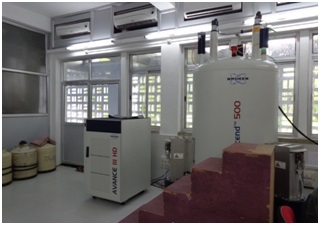





Sophisticated Analytical Instruments Facility
| Name of the equipment/facility: Nuclear Magnetic Resonance Spectrometer |  |
| Make: BRUKER, Switzerland | |
| Model: AVANCE III 500 MHz FT-NMR Spectrometer | |
| Specification: | |
5mm Multipurpose Broad band Probe with Automatic Tuning and Matching, Observation of 19F with 1H decoupling or observation of any nucleus from 31P to 15N. High performance 36 Orthogonal Shim gradients with smart magnet control system for shim and lock control and digital lock control unit with automatic facility. 2-Channel Amplifier System. 300/100/150 Amplifier system including high performance linear amplifier for observation or decoupling of 1H or 19F. Digital receiver unit for NMR signal accumulation with real time digital filtering. Digital temperature control system. |
|
| Working Principle: | |
Working principle of nuclear magnetic resonance (NMR) is based on the spins of atomic nuclei. Nuclei with an odd mass or odd atomic number have "nuclear spin" (in a similar fashion to the spin of electrons). Since a nucleus is a charged particle in motion, it will develop a magnetic field. When the nuclei with non-zero spins placed in a strong magnetic field with respect to the applied magnetic field with the supply of appropriate energy, these nuclei flip to a higher energy state from lower energy state. The energy difference between the two states depends on the applied field. The energy absorbed during this transition is a function of nucleus type and its chemical environment in the molecule. The magnetic field is increased and the excitation or “flipping” of nuclei from one orientation to another is detected as an induced voltage resulting from the absorption of energy from the radio frequency field. The free induction decay, which is in time domain gives its equivalent frequency domain signal on Fourier transformation. The area under a peak is proportional to the number of nuclei “flipping” and by observing the field strength at which protons absorb energy, one can know about the structure of a molecule. |
|
| Applications: | |
| Nuclear magnetic resonance is a key analytical technique for monitoring and defining molecular properties in such diverse fields as chemistry, biochemistry, structural biology, materials science, medicine, polymer chemistry and organometallic chemistry. The NMR technique is used in quality control and research for determining the content and purity of a sample as well as its molecular structure. NMR can quantitatively analyze mixtures containing known compounds. It is also one of the best media for illustration of basic principles of spectroscopy and data processing. |
|
| User Instructions: | |
| (A) Chemical safety:
(i) Research samples, glassware (NMR tubes, pipettes, etc.), chemical storage, spills, and waste disposal must be properly handled.
(ii) Any of the sample may have been spilled in the probe, please notify the staff immediately. Place a written notice on the spectrometer to inform the next user.
(iii) If NMR tube does not fit into the sample spinner, do NOT force it. NMR tubes are easy to break. (B) Cleanliness: (i) All sample preparation should be done carefully. Under no circumstances are samples to be prepared on the spectrometers or on the computer desks. Never place your NMR tubes horizontally on any surface, especially computer keyboards. (C) Precautions (i) The strong magnetic field can suddenly pull nearby unrestrained magnetic objects into the magnet with considerable force. Keep all tools, equipment and personal items containing ferromagnetic material (e.g., steel, iron) at least 2 metres away from the magnet. (ii) Though not a safety issue, advise users that the magnetic field can erase magnetic media such as tapes and floppy disks, disable credit and automated teller machine (ATM) cards, and damage analog watches. (iii) Avoid skin contact with cryogenic (liquid) helium and nitrogen; wear a protective face mask and loose-fitting thermal gloves during dewar servicing and when handling frozen samples. (iv) NMR tubes are thin-walled; handle them carefully and reserve them for NMR use only. (v) NMR Tubes and Caps: • NMR tubes are a standard length (7 and 9 inch). When chipped (and reduced in length) they should not be reused. • Always clean the tubes thoroughly after use with proper solvent and dry the sample tube laying flat on a layer of tissues. • Don’t heat the NMR tubes above 50 °C, as the glass might warp. (D) NMR sample preparation (i) NMR users are advised to provide 5-20 mg of sample depending upon its molecular weight for proton NMR spectra. At least 30 mg of sample is necessary for obtaining 13C NMR spectra with reasonable signal to noise ratio. (ii) The sample should be completely soluble in the given deuterated solvent. (iii) NMR samples should be provided the information to the NMR operator about the sample details: such as type, amount, solvent used spectral range require etc. in the given job card or samples accompanied by a letter containing analysis details. |
|
| Contact | |
| Division: Analytical Chemistry Group, CSTD Dr Prakash J Saikia, Scientist, saikiapj@neist.res.in, 9435096726 |
|
| Charges (Excluding Taxes) | |
| a) For National Labs( R&D) : Rs 1500.00 per sample b) University/Educational Institutes : Rs 1500.00 per sample c) Industry : Rs 1500.00 per sample |
|